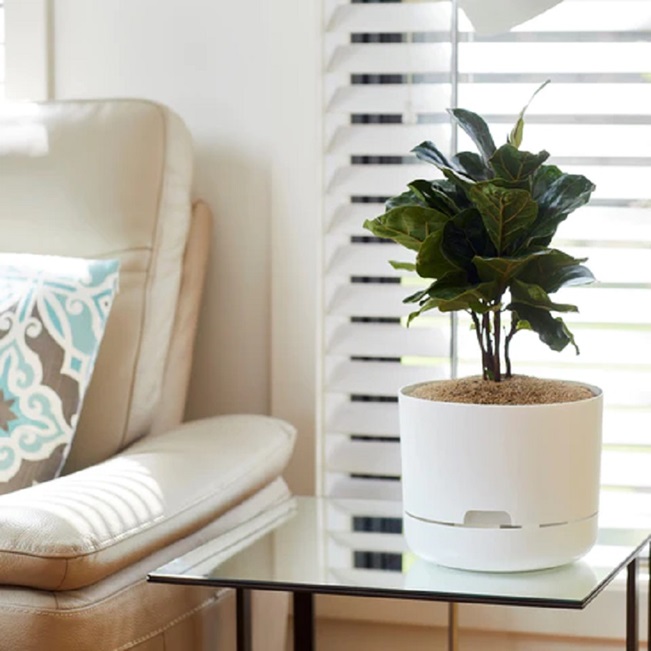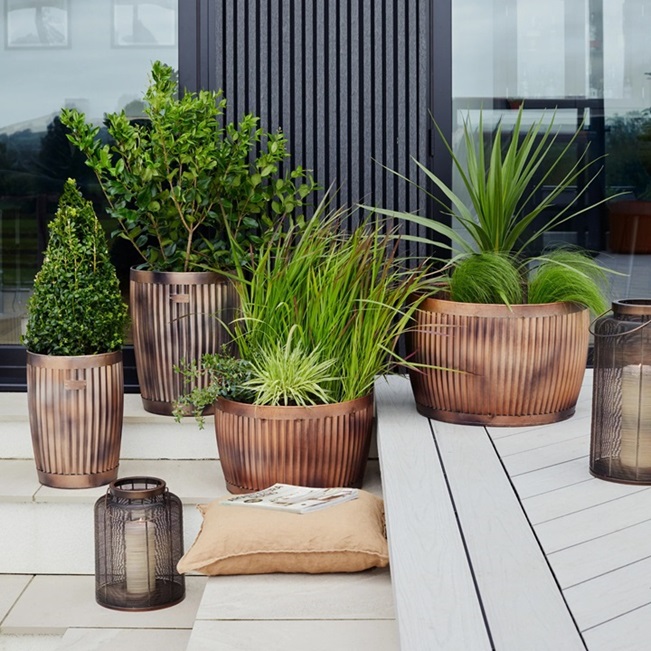When did you last water your plants? Did you forget again? While you might think your Monstera could have ‘tried harder’, let’s face it, so could you. But don’t quit on your gardening endeavour just yet. With a bit of help from a clever tool, your plants can thrive too!
Self-watering planter boxes are an innovative solution for both novice gardeners and experienced horticulturists looking to optimise their gardening efforts. These devices offer a convenient and efficient method of ensuring your plants receive the correct amount of water, directly at their roots, without the usual hassles. Here’s a breakdown of how they work and some tips on choosing and using them.
How Do Self-Watering Planters Work?

- Reservoir: These planters have a water reservoir located at the bottom. The reservoir stores water and supplies it gradually to the soil above through capillary action or wicking systems.
- Watering Wick or Column: Many self-watering planters use a wicking system made from materials like felt or cotton that extends from the reservoir into the soil. These wicks absorb water from the reservoir and distribute it evenly throughout the soil.
- Water Level Indicator: Some advanced models include a water level indicator to help you know when it’s time to refill the reservoir. This is especially useful to prevent over-watering or drying out.
- Overflow Hole: To ensure the plant’s roots do not sit in water, leading to root rot, most self-watering planters have an overflow hole at the side of the reservoir. This allows excess water to drain out when the reservoir is full.
What Are the Advantages of Self-Watering Planters?
Consistent Moisture Supply
The primary benefit of self-watering white planter boxes is their ability to provide a consistent water supply directly to the plant roots. These planters typically consist of a reservoir at the bottom that allows plants to wick up moisture as needed. This consistent availability of water promotes healthier plant growth and reduces the stress on plants from fluctuating moisture levels.
Water Efficiency
The self-watering pots reduce the need for frequent watering, thus conserving water which is especially beneficial in areas subject to drought or for gardeners looking to reduce their environmental footprint. Since the water is stored in a reservoir and used as needed by the plant, less water is lost to evaporation or runoff compared to traditional surface watering.
Time-Saving and Convenient
The white planter boxes are ideal for those with busy lifestyles. They reduce the need for daily watering, thereby saving time and making it easier to care for plants. This makes them particularly appealing to those who travel frequently or can’t dedicate time to daily garden maintenance.
Reduced Weeds and Diseases
Since water is applied directly to the root zone and not on the surface, the top layer of the soil tends to remain dry, discouraging the germination of weeds. Additionally, keeping the foliage dry helps prevent the spread of many common leaf diseases.
Better Root Growth
By encouraging roots to grow downward in search of water, self-watering planters promote a more extensive root system. Stronger root systems contribute to healthier, more resilient plants.
Versatility and Mobility
A self-water pot comes in various sizes and styles, making it suitable for both indoor and outdoor use, in the city or in a rural space. It can be relocated easily based on sun exposure and seasonal changes without much hassle.
What Can You Grow in Self-Watering Planter Boxes?
The white planter boxes are versatile enough to support a wide range of plants, from herbs and vegetables to houseplants and ornamental flowers. Here’s a look at what you can successfully grow in them:
- Vegetables: Many vegetables thrive in these containers due to their consistent water supply. Excellent choices include tomatoes, peppers, cucumbers, and leafy greens like lettuce, spinach, and Swiss chard. These plants benefit significantly from the constant moisture and nutrients available at their roots.
- Herbs: Herbs are particularly well-suited for self-watering planters because they require specific watering conditions that can be easily regulated in these containers. Herbs like basil, parsley, mint, cilantro, and thyme can prosper in the controlled environment provided by self-watering systems.
- Houseplants: Indoor plants such as peace lilies, African violets, and various ferns appreciate the stable moisture levels offered by self-watering planters. These are often sensitive to over or under-watering, making the self-watering system a perfect fit.
- Flowers: Many flowering plants, both annuals and perennials, can also be grown in these planters. Examples include impatiens, marigolds, petunias, and pansies. These flowers benefit from consistent moisture and can bloom more vigorously.
- Fruits: Certain small fruit varieties, like strawberries, can also be grown in larger self-watering planters. They benefit from the steady moisture and reduced risk of root rot.
Choosing the Right Planter Box

- Size and Depth: Ensure the planter is the right size and depth for the plants you wish to grow. Larger plants will require deeper and broader boxes.
- Material: They come in various materials including plastic, ceramic, and metal. Plastic is lightweight and often more affordable but may degrade over time in sunlight. Ceramic and metal can be more durable and aesthetically pleasing.
- Design: Consider the design based on where you plan to place them—indoors, outdoors, on a patio, or on a window sill. Some designs integrate with modern home décor more seamlessly than others.
How to Use Self-Watering Planters Effectively?
To maximise the benefits of a self-watering planter box, consider the following tips:
- Proper Setup: Ensure the reservoir is assembled correctly according to the manufacturer’s instructions. The wicking system should be optimal to allow an even distribution of moisture.
- Right Soil Mix: Use a potting mix suitable for self-watering containers. These mixes often contain peat moss or coconut coir to help wick moisture more effectively.
- Regular Maintenance: Check the water levels regularly and refill the reservoir as needed. Even though these planters reduce the frequency of watering, they do not eliminate it.
- Nutrient Management: Since water-soluble nutrients can be washed out of the soil into the reservoir, consider adding a slow-release fertiliser or supplement with a liquid fertiliser periodically.
Takeaway
Self-watering planter boxes offer a practical, efficient, and user-friendly option for growing a variety of plants. These systems are designed to ease the labour of gardening while ensuring plants thrive with minimal effort. Whether you are a beginner looking to start your first garden or an experienced green thumb seeking more convenience, these containers can enhance your gardening experience, promoting lush, healthy plant growth and a beautiful, vibrant garden.
























